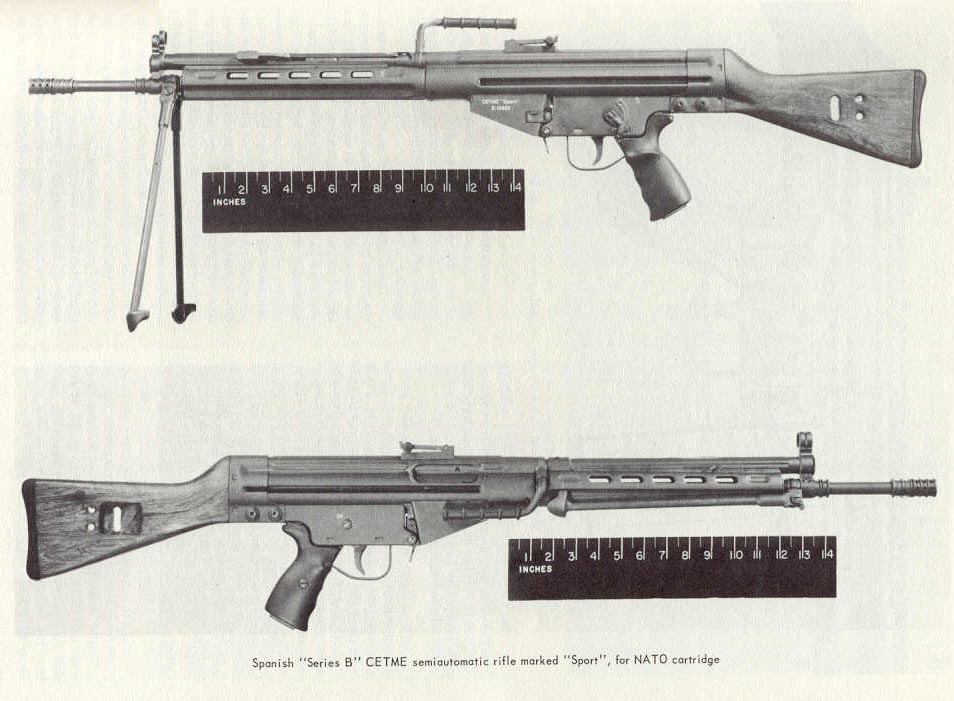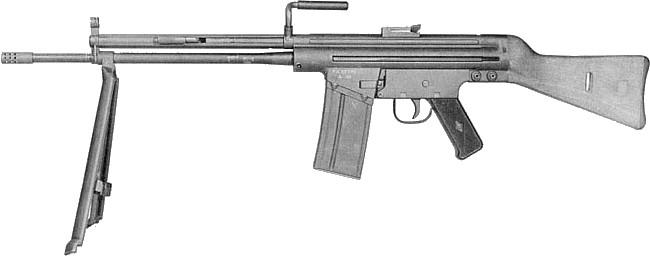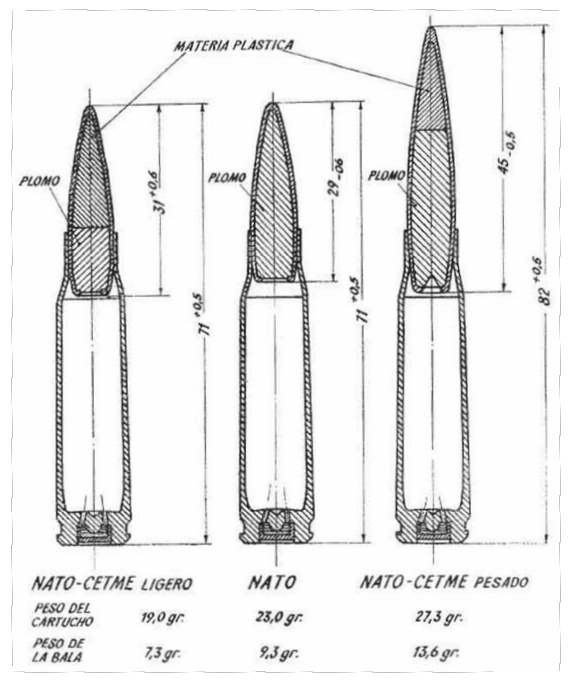The 7.62×51mm CETME is a variant of the 7.62×51mm NATO with a plastic-cored lead bullet and a reduced propellant charge. It was produced as a joint venture by the Spanish Government design and development establishment known as CETME (Centro de Estudios Técnicos de Materiales Especiales, or “Center for Technical Studies of Special Materials”) and the German arms manufacturer Heckler & Koch.

 1st Model
1st Model




Aluminium Core





 CSP-003 Bullet
CSP-003 Bullet
Doctor Günther Voss was a German engineer that came to Spain after WWII. While being a civil engineer, he also worked for the Spanish government. While working at CETME (Centro de Estudios Tecnicos de Materiales Especiales – Special Materials Technical Studies Center) on assault rifles he also invented different bullets. Some of them he patented, like the aluminium cored one for the then developing 7,92×40 CETME rifle, or the ‘spoon tips’ for the 4,6 x 36.
In September 1960 he wrote an article in the official Spanish Army journal, Ejército. Two years before, Spain had adopted the 7,62×51 caliber with a special light bullet and load for assault rifle use, but it seems that the army had set its eyes in the more powerful NATO cartridge adopted in Europe and the US. The article was titled “The unification of the infantry ammunition” and presented the following theories:
– The NATO round is too powerful and generates a heavier recoil. Its dispersion when fired in bursts is twice than that of the CETME light cartridge offering acceptable impact probabilities at relatively short distances only. The light CETME cartridge mentioned had the CSP-003 bullet, and the heavy one, the CSP-004. CSP stands for Cobre-Sintético-Plomo (Copper-Synthetic-Lead), and the number after the hyphen is the correlative number. The jacket was not copper but actually gilding metal (90/10 brass) and the synthetic plastic nose filler was black phenolic resin. Thus the assault rifle in NATO caliber cannot be a substitute for the light machine gun.
– The NATO cartridge has many drawbacks when used in a machine gun, because of the reduced bullet weight and inadequate bullet shape, in all probability the flat-based T65E3 bullet which had been tested at CETME. Because of this the NATO ballistics are sensibly worse than that of the 7,92 round with sS bullet. This inferiority shows especially at ranges exceeding 600 meters, precisely the range at which assault rifles are no longer useful. Thus the machine gun in 7,62 NATO caliber cannot be a substitute for the 7,92 mm machine gun.
According to Dr. Voss, the adoption of a new service round for the Spanish infantry should be made adopting the NATO cartridge as a basis, but with the advantages of the short assault rifle rounds and long machine gun rounds being developed in foreign countries. The high capacity of the NATO-CETME 7,62 x 51 case allows the use of flake powder manufactured in Spain. The smaller assault rifle rounds, as the NATO one, must be loaded with tubular or spheroidal powder that should be purchased abroad.
Rifles in 7,62 x 51 caliber are able to launch rifle grenades with 30 percent longer range than short-cartridge assault rifles. Plus, in case of an emergency, the CETME rifle can use the NATO ammunition as is. So the assault rifle problem is already fixed. The machine guns pose other problems because an improvement of the ballistics must be achieved. This can be done only by augmenting bullet length and weight, so only the case and the propellant charge from the NATO round have to be kept. But this is enough for allowing the use of this new improved ammunition along with the NATO cartridge in the same gun without any modification. The gun would be an Alfa machine gun adapted to the longer CSP-004 cartridge. Voss writes that Alfa machine guns modified for the new heavy cartridge (CSP-004) have been tested to reliably feed and fire standard 7,62 NATO rounds using original belts. Voss does not mention barrel twist rates, but the longer CSP-004 bullet should need a faster rifling than the NATO bullet. However, barrels with this faster rifling could use NATO bullets without problems. The existing Alfa machine guns need only a change of barrel and a lengthening of the feeding opening by some 2mm. In short, Dr. Voss proposed the following:
– Adoption of the 7,62 x 51 NATO caliber for infantry use.
– To keep the regulation 7,62 x 51 CETME light round (CSP-003) for assault rifle use.
– To adopt the 7,62 x 51 CETME heavy round (CSP-004) for machine gun use.
– In case of need, both the assault rifle and the machine gun can use the NATO cartridge without modifications to the gun or cartridge. (IAA Forum)

 CETME modelo A assault rifle, chambered for the 7.62x51mm reduced load
CETME modelo A assault rifle, chambered for the 7.62x51mm reduced load

